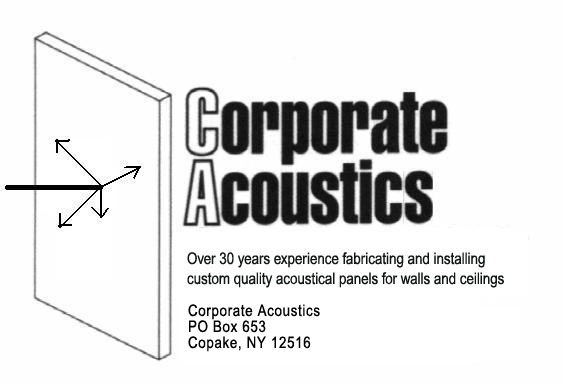 |
Email
Us at or Call (518) 789-6504 |
||
|
 |
Email
Us at or Call (518) 789-6504 |
||
|
Acoustical Ratings
Sound Absorption Coefficients (in sabins) versus Frequencies (in hertz)
ASTM E 90-81 and ASTM E 413-73, C423-81A, on Type A Mountings
Sound absorption is measured in Sabins. 1.0 Sabin is equivalent to 100 percent of the sound energy being absorbed. For example, the above sound absorption rating for a 1.0 inch thick panel core at a frequency of 500 Hz is 0.93 Sabins, or 93 percent absorption of sound energy at that frequency. Although it is theoretically incorrect to exceed 1.0 sabins, or 100 percent in absorption, some of the above ratings do because of "edge defraction".
N.R.C. or Noise Reduction Coefficient is only a relative indicator of a material's sound absorption. Acoustical consultants also carefully considers the absorption coefficients ranging between 125 and 4000 Hz.
The above ratings are predicated on covering panels with a open weave fabrics similar to Guilford of Maine FR701. Avoid very tightly woven fabrics which may restrict transference of sound energies at particular frequencies into the core material.
Maximum Custom Panel Dimensions: 60" X 120". Stock Dimensions: 48" X
120"
Curved Panels fabricated for concave surfaces only.
Tackable - Impact Resistant Panels are fabricated utilizing high density, sound
transparent substrates.
Edge Details:
Edge detailing, such as bevel, are more "forgiving' than square edges under most lighting conditions. Moreover, butted, square edge panels are impractical to replace because original fabric dye lots must be matched.
Fabric Finishes - Guilford of Maine FR701 fabrics & acceptable customer's own material (C.O.M.).
Some fabric textures and colors (especially light colors) may magnify minor core defects depending on the lighting that will exist in the installation location. Always carefully verify appearance with a large mock-up panel covered with the selected fabric.
Fire Rating - Glass fibre cores and Guilford of Maine's fabrics have Class 'A' Flame Spread Ratings of 25, or less. Recommend that other specified fabrics comply with local fire code.
Toxicity - Our resin hardener is water based and odor free. Beware of petroleum based resins !!!
Installation Techniques -Adhesively applied panels (which are still removable) usually result in superior installations than those with mechanical or fabric fasteners. However, mechanical and fabric fasteners are available if otherwise still requested. Magnets are available for very quick and effective applications to metal partitions. Please contact us at caleb.wright@corporateacoustics.com for specific instructions.
Drawings & Dimensions -Detailed shop drawings and accurate field dimensions are strongly recommended. If pre-arranged, this service will be provided whenever possible...as well as competent installation supervision.
Approval For Fabrication - requires purchaser's written acceptance of project's mock-up panels covered with the selected fabric and approval of shop drawings.
Suggested Specifications - Please contact us, for suggested specifications applicable for your project.
Custom Requirements - must be reviewed for feasibility followed by submittal of prototype sample panel requiring customer's written approval prior to fabrication.
Please note:- We do not recommend very light colored fabrics because of
likely discoloration over time due to airborne interior air pollutants, mold,
soiling, etc. During and after installation, comfortable levels of air conditioning
should be maintained so that panels are not exposed to high levels of temperature
and humidity.